
Aggression, much like beauty, is in the eye of the beholder, or the victim. A mouse, after all, may see an adored pet cat as incredibly aggressive, and crocodiles treat their babies with exquisite tenderness.
This article lists animals that have been known to be particularly aggressive toward humans, with aggression being defined as reacting purposefully and violently through biting, stinging, kicking, trampling, goring, or other behavior after what appears to be not a great deal of provocation.
Also, once the aggression starts, it is not easily stopped. The animal’s aggression also depends on their mood, whether they’re well-fed, the time of day, whether they have territory or young to defend and other factors. Here is a list of 8 of the most aggressive animals in the world:
#8 Barracuda
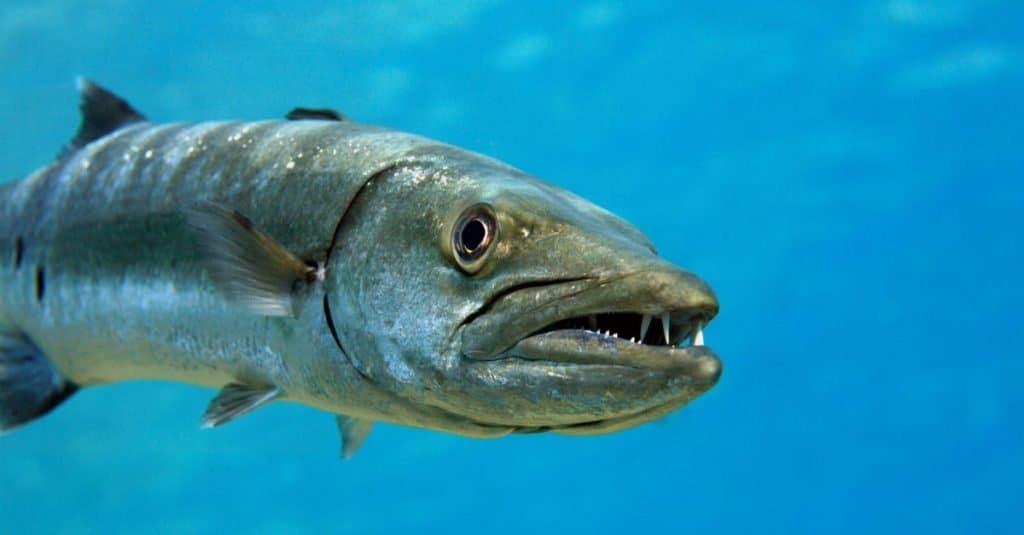
©aquapix/Shutterstock.com
In a contest between sharks and barracudas, even sharks that are fairly aggressive like the Great White, many fisherfolks give the barracuda an edge. Between 20 inches to 6.5 feet long, barracudas are both scavengers and ambush predators. Because of this, they may mistake a swimmer in their midst for a predator who has just had a meal and may be shedding bits of prey.
Barracudas have bad eyesight but are attracted to shiny objects, which they mistake for light glinting off the scales of a fish. They have powerful jaws filled with fangs and can swim in bursts of 25 miles per hour. Unlike the shark, which typically bites its prey multiple times before killing it, the barracuda aggressively tries to take out its prey in one massive bite.
While barracudas are certainly on our minds as dangerous threats to humans, their attack record is low compared to that of the shark. In fact, there are very few documented cases of victims dying from a barracuda attack, but barracudas do attack from time to time and can do damage, even causing a human victim to lose a limb.
Also, some predator fish like the barracuda consume algae that contain a toxin called ciguatera, which is poisonous to humans. A bite could give a person symptoms similar to those caused by food poisoning.
Barracudas are found in subtropical waters around the world and live around coral reefs. They belong to the genus Sphyraena, and there are 28 species. These include the Guinean barracuda, the northern sennet, the Mexican barracuda, the yellowtail barracuda, and the red barracuda.
Barracudas can be found in the New England Aquarium.
#7 Black Mamba

©Andre Coetzer/Shutterstock.com
Like most other animals, the black mamba does not seek confrontations with people, but when it is cornered it is notorious for its aggressiveness. It gets its name not so much from the color of its scales, which range from dark brown to gray, but from the color of the inside of its mouth when it gapes in a threat display.
Found in southern Africa and parts of central and east Africa, the black mamba often grows to over 9 feet in length, and snakes that were longer than 14 feet have been described. Only the king cobra is longer when it comes to venomous snakes.
The black mamba has a big reputation for being one of the world’s deadliest snakes. It is really fast on land and one of the longest venomous snakes in Africa and only the second in the entire world. Although deadly, these snakes won’t attack unless provoked and aren’t considered to be overly aggressive.
When it attacks, the mamba will bite and bite again and again, so the victim might have more than one set of toothmarks. The venom is a neurotoxin, and its effects are felt minutes after it’s delivered. If the person isn’t quickly treated with antivenin, they will die within seven to 15 hours as their cardiovascular system collapses.
The black mamba is found in the Houston and Atlanta zoos, and its conservation status is least concern.
#6 Chimpanzee

©Afandi Teguh Afriyanto/Shutterstock.com
One reason that chimpanzees don’t kill or injure more humans than they do is that they are elusive and difficult to find in their natural habitat. Once thought peaceable, it became obvious to researchers such as Jane Goodall that chimps can behave with a nearly humanlike viciousness. In some sense, they lack a theory of mind, which means they can’t understand or empathize with their victims.
The horror of chimpanzee attacks on humans is that they are intelligent enough to attack those areas of the human body that humans value, such as the face, the hands, or, in males at least, the genitals. Yet chimps, who are 1.3 to 1.5 times stronger than humans, are animal enough to be relentless.
Chimpanzees have been known to kill and eat human babies, probably mistaking them for their favorite primate prey, colobus monkeys. Chimps also attack people who get them drunk or who they view as rivals. St. James Davis, a former NASCAR driver, was severely mauled by two chimps who became jealous after he’d brought a birthday cake for his former pet chimp Moe and didn’t share any with them. Still, too many people keep chimpanzees as pets or even surrogate children.
Like hippos, chimps are popular at zoos, including the San Diego Zoo. Their conservation status is endangered.
#5 African Buffalo

.
©nelik/Shutterstock.com
Unlike the hippopotamus, the African buffalo’s huge, curved horns and robust, muscular body keeps humans from thinking it is cuddly. One of the big five of big game hunters, it has a reputation for both aggressiveness and what seems like vengeance.
Only the lion and the biggest crocodiles think of it as potential prey. Unlike its Asian cousin the water buffalo, humans never domesticated the African buffalo.
The African buffalo kills about 200 people a year, though it’s not as aggressive as the hippopotamus. The biggest buffaloes can be from 5.56 to a little over 11 feet long with a 2 to 3-foot-long tail and can weigh between 1100 and 2200 pounds.
The male’s vicious horns come together to form a boss at the top of its head and sweep down and back to come to very sharp points. It takes eight or nine years for the boss to harden. Cows, which are smaller than bulls, have horns, but they don’t sport the boss.
There are five species of African buffalo. They are:
- Cape buffalo
- Forest buffalo
- Sudan buffalo
- Nile buffalo
- Virunga buffalo
Zoos that have enough room for this animal include Denver Zoo. Its conservation status is least concern.
#4 Horsefly
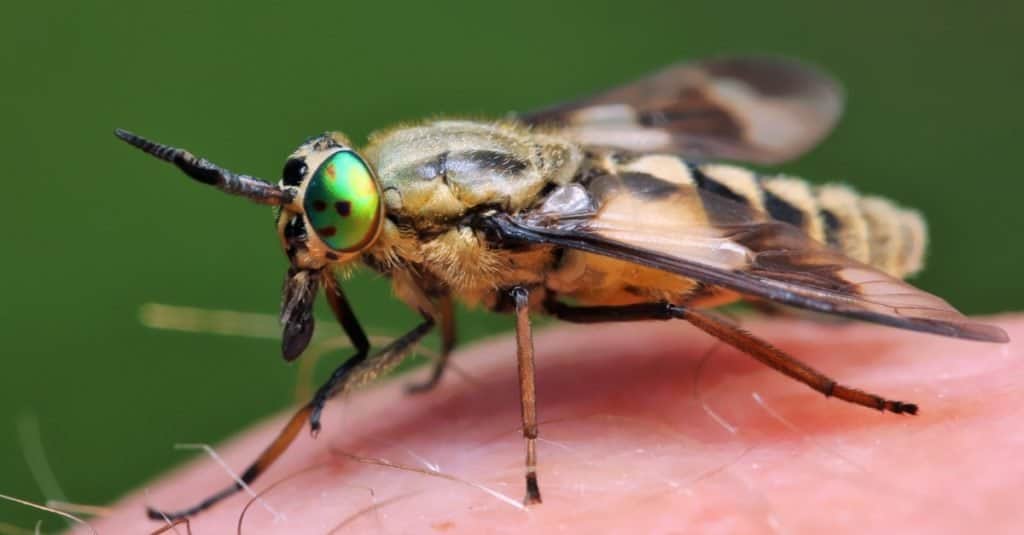
©Achkin/Shutterstock.com
Like the mosquito, the female horsefly needs a blood meal in order to successfully reproduce. Unlike the female mosquito, the horsefly does not approach its victim tentatively nor is it easily dissuaded. Moreover, its bite is memorably painful. Biologists believe this is because the horsefly evolved to bite animals that couldn’t easily swat it away, so it didn’t bother to evolve an anesthetic in its saliva like the mosquito.
Depending on the species, the horsefly is a medium to large insect between 0.2 and 2.4 inches long. Most are brown, grayish-brown, or black, with huge compound eyes that can be iridescent in life. The horsefly uses its Swiss Army knife-like mouthparts to slice open a wound and enlarge it.
It then laps up the blood and adds anticoagulants to keep it from clotting. Because the bite is so painful, the horsefly will be quickly brushed away. In that case, it will either keep trying to come back or find another host. This is how the horsefly spreads diseases and parasites.
#3 Hippopotamus

©Karel Bartik/Shutterstock.com
People simply can’t believe that hippos are as aggressive as they are. Blubbery, herbivorous, seemingly lethargic, partially aquatic with incredibly cute babies, it is astonishing to learn that hippos kill at least 500 people every year. Found nearly everywhere in sub-Saharan Africa as well as along the Nile River, the hippo can move surprisingly fast on land. A determined hippo can sprint at 19 miles per hour.
Hippopotami belong to the Hippopotamus genus. There are five subspecies:
- Nile hippo
- East African hippo
- Cape hippo
- West African hippo
- Angola hippo
The pygmy hippopotamus is not a subspecies but belongs to a different genus entirely.
A hippo can grow between 9.5 to nearly 17 feet long, excluding a tail that’s a bit over a foot in length. They stand from 4 to 5 feet tall at the shoulder and easily weigh over a ton. A big male can weigh over 2 tons, and not only that, males never stop growing during their 50-year lifespan.
Their lower incisors and astonishing lower canine teeth also never stop growing, and they have been known to use this impressive weaponry to kill people. People are also overcome and trampled on land. Hippos are also fond of capsizing small boats and then attacking the people who fall into the water.
Hippopotami are popular attractions in many zoos around the world, including the Toledo Hippoquarium, which saw the first underwater hippo birth. The San Diego Zoo and the San Antonio Zoo also exhibit hippos. The conservation status of the hippopotamus is vulnerable.
#2 Fire Ant
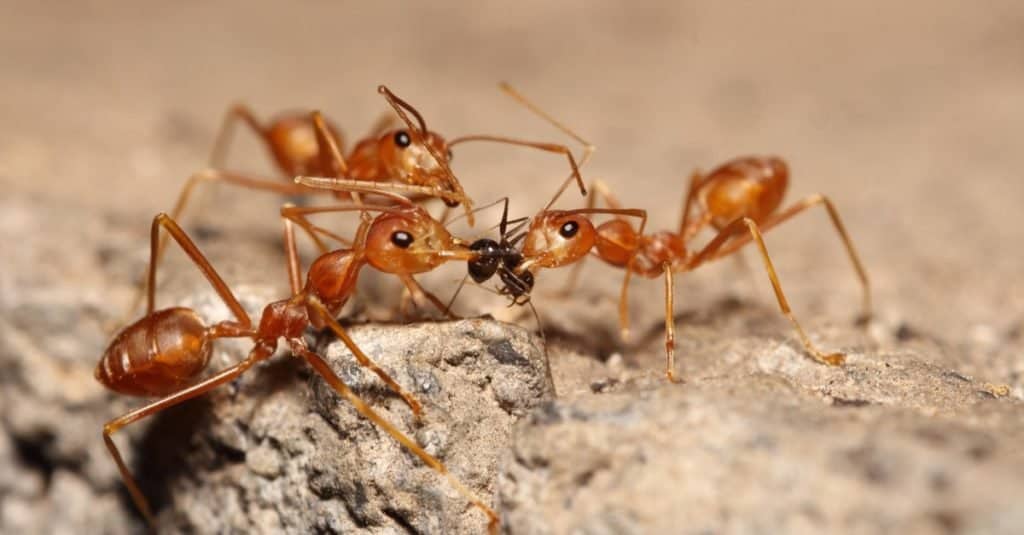
©sarawuth wannasathit/Shutterstock.com
The fire ant gets the number two spot because it is one of the few animals that attack for what seems like no reason whatsoever. Social insects such as wasps or bees can be expected to defend their colony, but a fire ant that is simply patrolling around will crawl up on a barefoot and sting and bite for what seems like no other reason than the foot is in its way.
While its sting may not be as hideously and lastingly painful as the sting of South America’s bullet ant, the fire ant comes by its name honestly. The pain of its sting feels like being pierced by a red-hot needle and lasts for some hours.
The sting is followed by a welt, then a bleb that dries out over time if it is left alone. People who are sensitive to the fire ant’s venom, which is made of poisons called solenopsins, can become ill if they are bitten by many fire ants, and some can even go into anaphylactic shock.
Fire ants are not only aggressive toward people but toward other species of ants. It is unusual to find an area where fire ants and other types of ants live harmoniously.
#1 Nile Crocodile
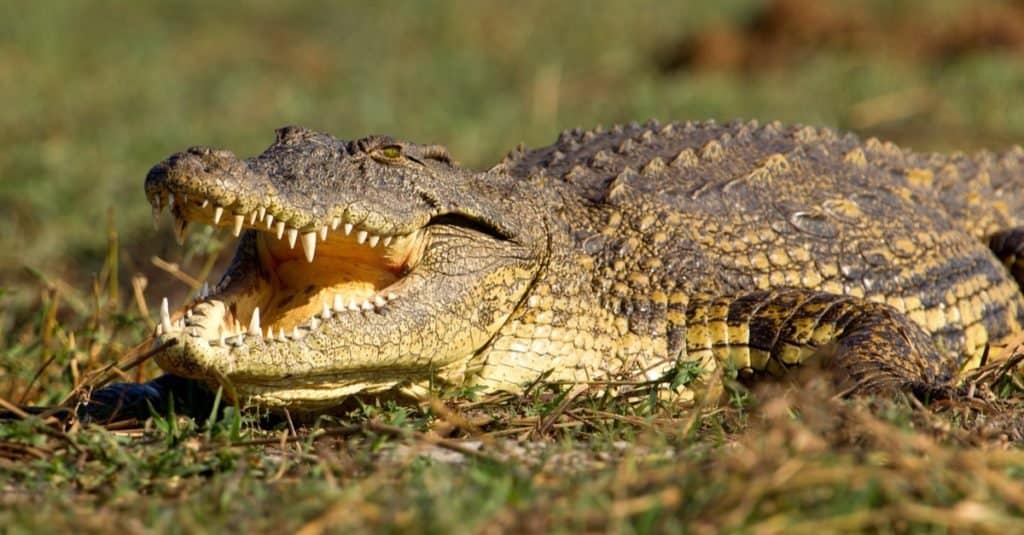
©Gaston Piccinetti/Shutterstock.com
The Nile crocodile gets the number one spot because it is the only animal on the list to consider humans a regular part of its diet. It’s just as likely to grab a human that strays too close to the water’s edge as it would a wildebeest. Hundreds of people are killed by the Nile crocodile every year.
This crocodile is found in at least 26 countries in sub-Saharan Africa and lives in fresh or slightly brackish water. The length of a male is between 11.5 and 16 feet, and it can weigh between 500 and 1650 pounds, though there have been cases of crocodiles longer than 20 feet that weigh over a ton. Females are 30 percent smaller than males. The Nile crocodile’s conservation status is the least concern.
The Nile crocodile is an ambush predator whose jaws are uniquely powerful and whose teeth are tough and sharp enough to pierce through the hide. Because of the unbreakable grip of its jaws, all a Nile crocodile needs to do is drag even a large animal underwater and wait for it to drown before it starts to feed.
As its teeth are made for gripping and not chewing, the crocodile goes into what’s called a death roll to tear its prey to pieces, the better to swallow it.
Nile crocodiles can be found in the Bronx Zoo.
How Long Do These Aggressive Creatures Live?
Barracudas: These fish have a lifespan of 14 years. Which may not seem that impressive compared with longlived specimens such as sturgeons which get to live for up to 100 years. However, these predators have the powers of prolific production on their side. One barracuda is capable of producing between 5,000 – 300,000 eggs. And while several of them will be converted to calories for several forms of marine life, quite a few will make it to adulthood: and continue the vicious cycle.
Black mambas: These reptiles generally have a lifespan of 11 years — pretty similar to several species of rattlesnake. However, when provided with expert care, that number lengthens to more than double its original value and the world’s most fearsome serpent has been known to live for as long as 25 years.
Chimpanzees: In the wild chimpanzees get to frighten their victims for a relatively short duration since they live for over a decade. However, in captivity, that number can triple and they have been known to live to the ripe old age of 39.
African Buffalos: One of the main prey species capable of giving lions pause gets to live longer than its main foe: African buffalos have a lifespan of 23 years compared to their maned nemeses which only live for 14.
Horseflies: From the time they emerge as fully-winged adults, these arthropods have a lifespan of about a month or two. And while it happens to be relatively short, it is long enough for them to deal discomfort to several victims.
Hippopotamuses: These mighty pachyderms might take six years to reach their full size. However, they still have about 30 or 40 years to expend their aggression on any living creature that takes their fancy since they generally live for about 40 – 50 years.
Fire ants: The arthropods renowned for their burning stings get to live longer than wasps and horseflies which only have weeks of adult life before them at the very most. Fire ants live for about 5 months on average while their queen might live even far longer — possibly six years.
Nile crocodiles: Crocs are some of the longest-lived reptiles on the planet. And it’s no different for these apex predators either. Nile crocs have a lifespan of 50 to 60 years during which they do their best to gobble everything in sight, other apex predators, included.
Is Aggression Normal Behavior In The Animal Kingdom?
Aggression is a normal behavior in the animal kingdom and is observed in many different species. It can serve a variety of purposes such as competition for resources, territory, or mates, and can also be used for self-defense or to protect offspring.
In many cases, aggression is related to the competition for resources such as food, water, and shelter. For example, territorial animals like deer, lions, and birds of prey will use aggression to defend their territory against other animals of the same species or other animals that may be competing for the same resources.
Mating behavior can also lead to aggression, as animals may compete for access to potential mates. For example, male deer will engage in fierce fights during the mating season to determine dominance and access to females.
Self-defense and protection of offspring are also common reasons for aggression in animals. For example, a mother bear will fiercely defend her cubs against any perceived threats.
It’s worth noting that aggression is not always physical, in some cases it can be vocal, posturing or even chemical. Also, not all aggression is harmful, some animals use it in a ritualized way that does not lead to injury.
In summary, aggression is a common behavior in the animal kingdom, serving various functions such as competition for resources and mates, self-defense, and protection of offspring.
Summary Of The Top 8 Most Aggressive Animals In The World
| Rank | Animal | Example Length | Example Weight |
|---|---|---|---|
| 1 | Nile Crocodile | 14 ft | 900 lbs |
| 2 | Fire Ant | 0.2 in | 2 mg |
| 3 | Hippopotamus | 15 ft | 5,000 lbs |
| 4 | Horsefly | 1 in | 0.02 g |
| 5 | African Buffalo | 11 ft | 1,500 lbs |
| 6 | Chimpanzee | 5 ft | 100 lbs |
| 7 | Black Mamba | 10 ft | 4 lbs |
| 8 | Barracuda | 5 ft | 12 lbs |
Bonus: Three More Aggressive Animals
Our survey of the world’s most aggressive animals wouldn’t be complete without the three bonus bullies we are adding. Two are only a threat in their native habitats – while one creature has claimed the entire planet for its own. Everyone can fear a chance encounter with a horrifying wild hog!
Wolverine
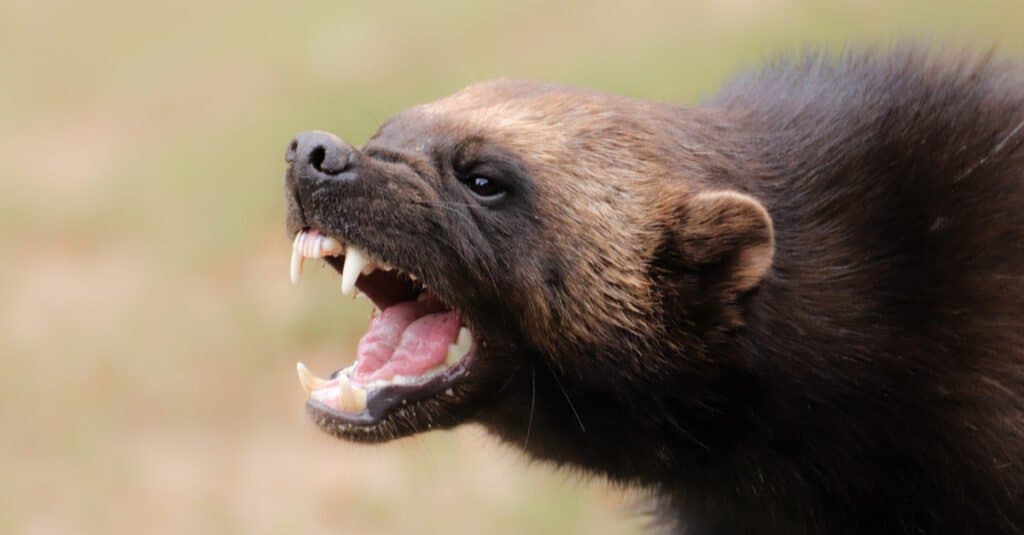
Wolverines are ferocious predators believed to kill prey much larger than themselves.
©DenisaPro/Shutterstock.com
Wolverines are fearless little animals that are too fierce to be cute. Weighing in at under 40 pounds – they are little powerhouses that put every pound and every tool they have to good use. Those tools include razor-sharp teeth and claws that rip and tear flesh like paper. Wolverines rip into flesh while snarling and hissing – a piece of most terrifying background music.
Wild Boar
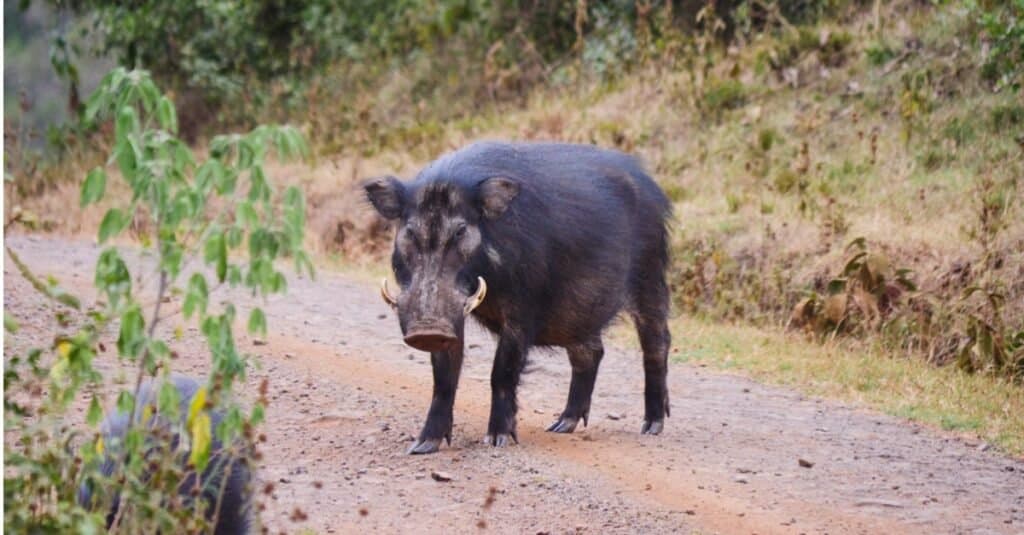
Wild boars are dangerous creatures capable of inflecting serious wounds.
©iStock.com/chingkai huang
Wild boars can be found digging, multiplying, and wreaking havoc all over the world. Known for their aggressive and territorial behavior, these muscular wild hogs waste no time sizing up a threat – they just charge full speed. If you can’t outrun them – which is doubtful – they will hit with unimaginable force – piercing flesh with sharp tusks that can deal a lot of damage. Wild boars have been known to attack humans without any provocation – so it is important to give these animals a wide berth.
Polar Bears

Polar bears
have been known to hunt and eat humans.
©imperio10/Shutterstock.com
Polar bears are massive carnivores on a constant hunt for meat – pounds and pounds of meat. They usually eat seals – but as the ice melts in the warming climate – the shrinking frozen border between polar bears and civilization has forced them to seek nourishment elsewhere. These terrifying bears are known to have hunted and eaten humans. Reaching a maximum weight of 1700 pounds and with a bone-crushing bite force of 1200 PSI – not to mention long claws that can lash with unbelievable power – the polar bear attacks to kill.
The photo featured at the top of this post is © PhotocechCZ/Shutterstock.com
Thank you for reading! Have some feedback for us? Contact the AZ Animals editorial team.







